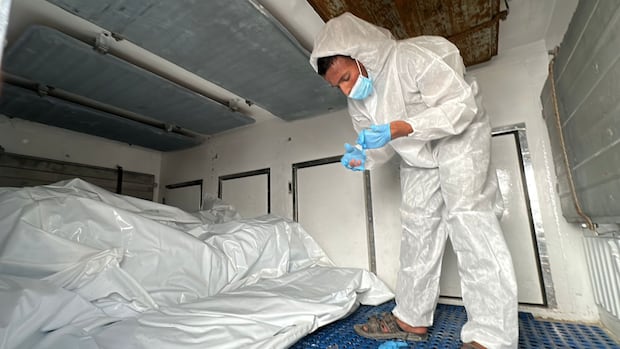Forensic experts in Gaza are working to identify dozens of dead Palestinians released by Israel Wednesday that they say show signs of physical abuse. Meanwhile, Israel said one of the four bodies handed over by Hamas a day earlier was not one of the hostages held in the territory.
Israeli Prime Minister Benjamin Netanyahu demanded Wednesday that Hamas fulfil the requirements laid out in the ceasefire deal, saying Israel will “not compromise on this and will not stop our efforts until we return the last deceased hostage.”
Hours after Netanyahu’s comments Israel transferred 45 more bodies of Palestinians as part of the ceasefire deal, according to the Gaza Health Ministry.
The latest transfer comes a day after the Nasser Hospital in the southern Gaza city of Khan Younis received 45 bodies of Palestinians that Israel handed over to the Red Cross the previous day without identification — bringing the total number of dead Palestinians released by Israel to 90 since the ceasefire began last week.
It isn’t clear whether the unidentified bodies, marked only by numerical identifiers, were those of people who died in Israeli prisons or were bodies taken from Gaza by Israeli troops.

Dr. Ahmed Duheir, director of forensic medicine at Nasser Hospital, says their forensics team confirmed the bodies showed signs of physical abuse.
He said the first batch of bodies arrived Tuesday, and all of them had their hands or feet bound. The bodies transferred Wednesday had also been bound, and several had blindfolds over their eyes. Some remains had already begun to decompose, making it more difficult to identify them.
“Unfortunately, we have very basic tools for the identification process. We don’t have modern or advanced devices that we use,” Duheir said, adding that he hopes they can get assistance from Israel for more advanced DNA testing.
Duheir said so far, health officials have only received names for three out of the 90 unidentified bodies, but their identities have not yet been matched.
Sameh Hamad, a member of a commission tasked with receiving the bodies at the hospital, said some showed signs of torture and executions.
He said the bodies belonged to men between the ages of 25 to 70, and most still had straps around their necks, while one had a rope. He told The Associated Press that most of the bodies were brought in civilian clothing but some wore camouflage uniforms.
Officials on Tuesday said they expect a total of 450 bodies to be handed over, but Israeli officials have not said how many are in its custody or how many will be returned.
WATCH | Trump demands Hamas disarm after saying Phase 2 of ceasefire is underway:
U.S. President Donald Trump says if Hamas does not disarm, the U.S. will disarm them ‘quickly and perhaps violently.’
The Al-Ahli Arab Baptist Hospital received two bodies of people killed in drone fire in the Shuja’iyya neighbourhood on Wednesday, east of Gaza City, local health authorities said. No immediate comment was provided by the Israel Defence Forces (IDF).
The latest deaths come a day after Israeli forces killed seven people across the coastal enclave despite the ongoing ceasefire.
Meanwhile, the flow of humanitarian aid to Gaza has resumed after a two-day halt. The Egyptian Red Crescent said 400 trucks carrying food, fuel and medical supplies were bound for the Gaza Strip on Wednesday, while Israel and Hamas argue over the slow return of the bodies of deceased hostages.
Unidentified body released from Gaza
The IDF said Wednesday that Red Cross had received remains of two more Hamas hostages to be returned to Israel from Gaza.
Israel’s military said the coffins would be transferred to its forces in Gaza.
The transfers came hours after Israel said one of the bodies previously turned over was not that of a hostage, testing the fragile truce that paused the two-year war last week.
Four bodies were handed over by Hamas on Tuesday, following the first four on Monday — when the last 20 living hostages were released. In all, Israel was awaiting the return of the bodies of 28 deceased hostages.
Of that second group of four bodies, three were identified — Uriel Baruch, Tamir Nimrodi and Eitan Levi.
The military said that “following the completion of examinations at the National Institute of Forensic Medicine, the fourth body handed over to Israel by Hamas does not match any of the hostages.”
The U.S.-proposed ceasefire plan had called for all hostages — living and dead — to be handed over by a deadline that expired on Monday. But under the deal, if that didn’t happen, Hamas was to share information about deceased hostages and try to return them as soon as possible.

Israeli officials said they had decided to restrict aid at the southern Rafah crossing that borders Egypt, allowing only half the agreed upon number of aid trucks into Gaza starting Wednesday, because Hamas had violated the ceasefire deal by failing to turn over the bodies of hostages.
This is not the first time Hamas has returned the wrong body to Israel. Earlier this year during a previous ceasefire, the group said it handed over the bodies of Shiri Bibas and her two sons.
Hamas raises concerns about shootings
Hazem Kassem, a spokesperson for Hamas, said on the group’s Telegram channel Wednesday that the group was working to return the bodies of the hostages as agreed in the ceasefire deal.
He accused Israel of violating the deal with shootings Tuesday in eastern Gaza City and the territory’s southern city of Rafah.
WATCH | Power vacuum in Gaza as Hamas is weakened:
As a fragile ceasefire takes hold, rival gangs are attacking each other and Hamas inside Gaza. For The National, CBC’s Eli Glasner breaks down where the different groups came from and how they’ve been fuelled by the chaos of war.
Israel’s defence minister, Israel Katz, said Wednesday the military is operating along the deployment lines laid out in the deal and warned that anyone approaching the deployment line will be targeted — as had happened on Tuesday with several militants.
On Monday, Israelis celebrated the return of the last 20 living hostages in Gaza, and Palestinians rejoiced at Israel’s release of some 2,000 prisoners and detainees as part of the first phase of the ceasefire.
Hamas and the Red Cross have said that recovering the remains of dead hostages was a challenge because of the vast destruction of Gaza, and Hamas told mediators that some remains are in areas controlled by Israeli troops.
At least 16 more bodies of people recovered under rubble were brought to hospitals in Gaza over the past 24 hours. That has brought the death toll from the Israel-Hamas war to 67,938 since Oct. 7, 2023, the ministry said, noting that another 169,638 have been wounded.
WATCH | International force for Gaza among the sticking points:
CBC News chief correspondent Adrienne Arsenault asks Monk School of Global Affairs founding director Janice Stein to break down what’s know about the negotiations behind U.S. President Donald Trump’s Gaza peace deal.








